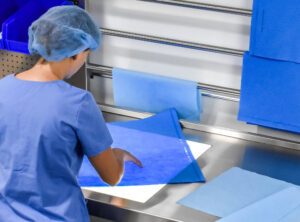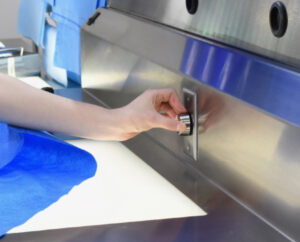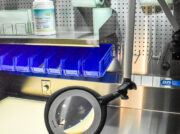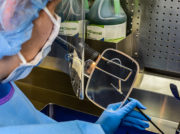
Luminosity Requirements in Instrument Reprocessing and Inspection
Medical device inspection is a required step in both decontamination and prep & pack. Along with magnification and the recommended borescope inspection, there is one other important resource: Lighting. Often placed in areas of the hospital with minimal or poor access to natural light, sterile processing departments often feel as though they’re poorly lit, and they often are. ANSI/AAMI has provided guidance on the measure and quality of lighting that sterile processing and endoscopy departments should have.
Guidelines on Lighting
ANSI/AAMI ST79 and ST91 both detail guidelines for lighting, as well definitive illuminance for given work areas and functions, according to the recommendations by the Illuminating Engineering Society of North America (IES).
| Work area/function | Least Illuminance | Average Illuminance | Highest Illuminance |
| General Inspection | 500 lux
(50 foot-candles) |
750 lux
(75 foot-candles) |
1000 lux
(100 foot-candles) |
| Detailed Inspection | 1000 lux
(100 foot-candles) |
1500 lux
(150 foot-candles) |
2000 lux
(200 foot-candles) |
| Sink Areas | 500 lux
(50 foot-candles) |
750 lux
(75 foot-candles) |
1000 lux
(100 foot-candles) |
| General Work Areas | 200 lux
(20 foot-candles) |
300 lux
(30 foot-candles) |
500 lux
(50 foot-candles) |
| Processed Storage | 200 lux
(20 foot-candles) |
300 lux
(30 foot-candles) |
500 lux
(50 foot-candles) |
*See table in ANSI/AAMI ST79:2017 (4.3.8 Lighting) and ANSI/AAMI ST91:2021 (3.3.5.6 Lighting).
These lighting recommendations are not one-size-fits-all. Three considerations need to also be accounted for when assessing the optimal illumination of a working area in a reprocessing department:
- The age of the employees working in the space. Employees under the age of 40 require the least illuminance, while older employees above the age of 55 require the most, with those 40-55 requiring an average amount of light in their working area.
- Speed and accuracy of the work being done in the area. Work requiring high accuracy and speed, or that is otherwise deemed critically important, requires more illumination.
- The amount of light reflection in the work area. Lighter materials will reflect more light, meaning darkly colored materials will require additional lighting to achieve optimal inspection conditions.
Hindrances to Lighting Outcomes
The location within the facility isn’t the only hinderance when it comes to lighting quality. Many factors can contribute to poorly lit sterile processing or gastroenterology departments:
- Obstructions: Shelving, equipment, or materials at sinks or tables can block light sources meant to illuminate the working area. The shadows cast by these obstructions make it difficult for technicians and nurses to properly complete tasks and inspect instruments.

- Adjustability: Many lighting solutions utilized in decontamination and prep & pack do not offer the ability to adjust brightness. This can lead to inadequate lighting in areas with low reflectivity surfaces, or too much glare in areas with high reflectivity, causing eye strain.
- Reliance on overhead lighting: Departments relying solely on overhead, ceiling-mounted lighting solutions are likely to have inadequate illumination in many working areas. These lights are easily obstructed not only by shelving, equipment, and materials, but by the technicians and nurses themselves. Further, overhead lighting isn’t always rated for high-illuminance tasks and working areas.
Conclusion
Lighting is a concern many SPD and GI departments struggle with, but it doesn’t have to be. ANSI/AAMI standards point to specific luminosities for various working areas, with consideration for employees’ ages, nature of work, and reflectivity of the working environment in mind. Addressing some common challenges, such as removing obstructions, implementing adjustable lighting options, and lessening the reliance on overhead lighting, are easy ways departments can start improving their lighting conditions.
Looking for ways to brighten up your department? We’d love to help!





